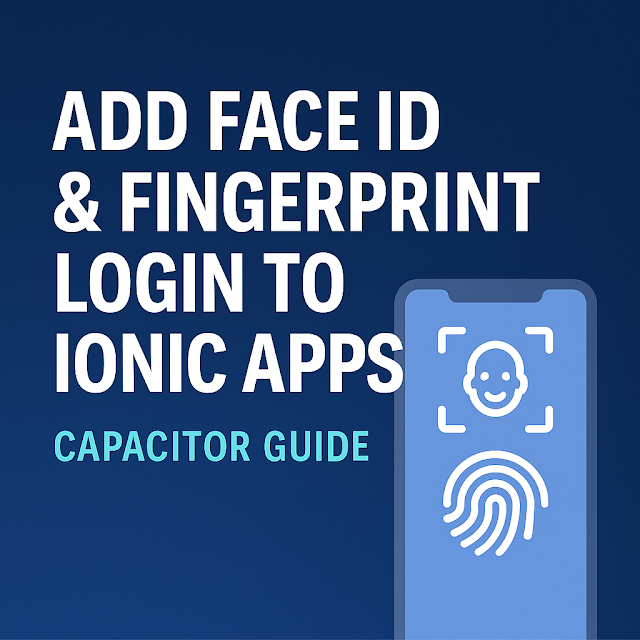Learn How to Add Biometric Authentication (Face ID & Fingerprint) to Your Ionic App with Capacitor
Biometric authentication—Face ID, Touch ID, and fingerprint scanning—is now the gold standard for securing apps. For Ionic developers, integrating biometrics has become easy thanks to Capacitor’s plugin ecosystem. In this guide, you’ll learn to add Face ID and fingerprint login to your Ionic app, improving both security and user experience.
Why Add Biometric Authentication?
- Enhanced Security: Biometrics use hardware-level encryption, making unauthorized access nearly impossible.
- User Convenience: No more typing passwords; users can log in instantly.
- User Trust: Modern apps are expected to support secure, frictionless login.
Prerequisites
- Ionic CLI installed
- Capacitor project set up
- Node.js LTS installed
- A test device with Face ID (iOS) or fingerprint unlock (Android)
Step 1: Create an Ionic + Capacitor App
If you don’t have a project yet, create one:
npm install -g @ionic/cli
ionic start biometric-demo blank --type=angular
cd biometric-demo
Add a Capacitor to the project:
ionic capacitor add ios
ionic capacitor add android
Step 2: Install the Biometric Plugin
Capacitor provides a community-maintained plugin for fingerprint and Face ID:
npm install @capacitor-fingerprint-auth
npx cap sync
Step 3: Configure Platform Permissions
iOS Setup
Open your project in Xcode:npx cap open ios
Enable Face ID under Signing & Capabilities.
Add a usage description in Info.plist:
<key>NSFaceIDUsageDescription</key><string>This app uses Face ID for secure authentication.</string>
Android Setup
No additional configuration is required. Ensure your device has fingerprint or face unlock enabled.
Step 4: Implement Biometric Authentication
Open home.page.ts and add:
import { Component } from '@angular/core';
import { FingerprintAuth } from '@capacitor-fingerprint-auth';
@Component({
selector: 'app-home',
templateUrl: 'home.page.html',
})
export class HomePage {
async authenticate() {
const result = await FingerprintAuth.authenticate({
reason: 'Please authenticate to access your account',
description: 'Use your fingerprint or Face ID to log in',
});
if (result.verified) {
console.log('Authentication successful!');
// Navigate to your app’s secure area
} else {
console.log('Authentication failed or was cancelled.');
}
}
}
And update home.page.html:
<ion-content class="ion-padding">
<ion-button expand="full" (click)="authenticate()">
Login with Biometrics
</ion-button>
</ion-content>
Step 5: Test on Real Devices
- iOS: Face ID requires real hardware; simulators do not support it.
- Android: Use any device with fingerprint/face unlock set up.
Run:
ionic capacitor run ios
ionic capacitor run android
Step 6: Best Practices
- Always Offer a Fallback – Provide password or PIN login if biometrics fail.
- Use Biometrics Sparingly – Prompt users only when necessary.
- Secure Tokens in Storage – Store sensitive data in Capacitor Secure Storage or native Keychain/Keystore.
Troubleshooting
- Plugin not recognized: Ensure
npx cap syncwas run after installation. - Face ID prompt not showing: Check
NSFaceIDUsageDescriptionis set correctly in Info.plist. - Authentication fails on Android: Ensure fingerprint is set up in device security settings.
Conclusion
With just a few steps, you’ve integrated Face ID and fingerprint authentication into your Ionic app using Capacitor. This enhances security, improves UX, and builds user trust. You can expand further by combining biometrics with secure token storage, PIN fallback, and session timeouts for enterprise-grade security.





1 Comments
Excellent guide! Adding Face ID and fingerprint authentication greatly improves app security and user experience. To achieve flawless integration, businesses should Hire Ionic Developers who have the expertise to implement biometric login efficiently and deliver reliable, user-friendly solutions.
ReplyDelete